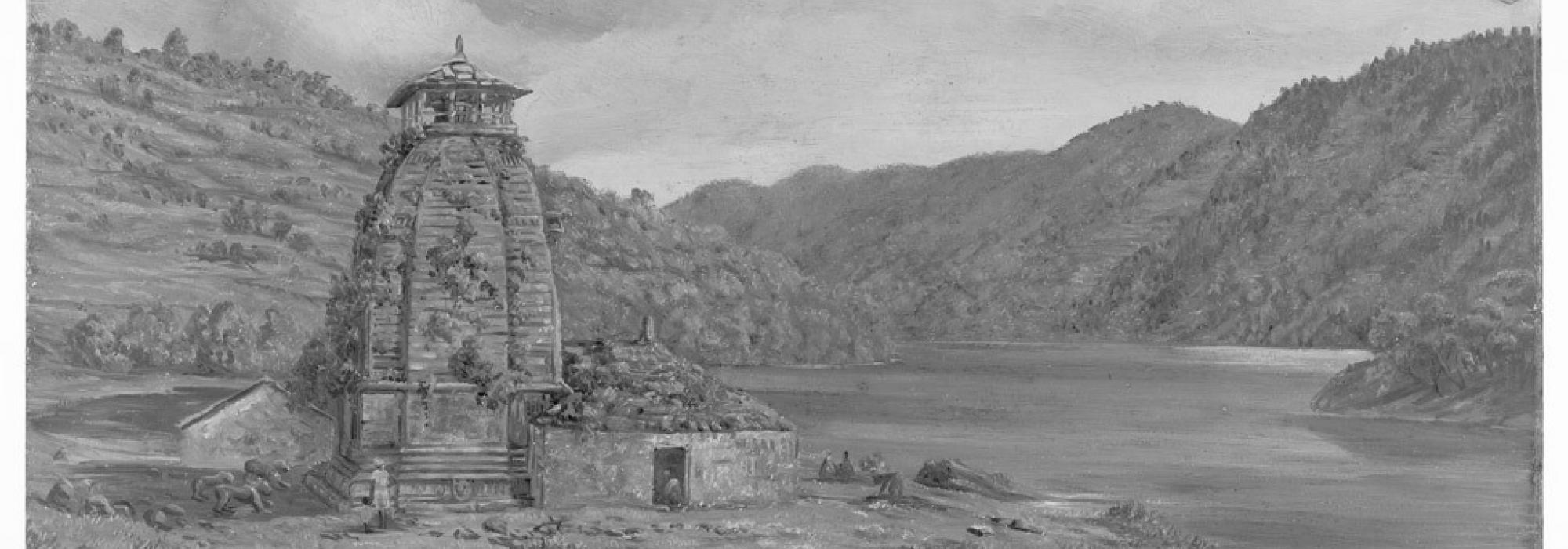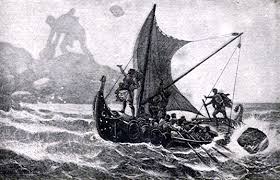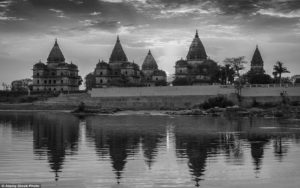A paper titled “A Study of the Significance of Travel in Classical Sanskrit Epics with Parallels in Greco-Roman Epics” was presented by Arjun Bharadwaj at the international seminar on “Sanskrit and Cultural Studies: New Perspectives” organized by the Sree Shankaracharya University of Sanskrit, Kalady on 5th June 2017. The current article contains excerpts from the paper.
Introduction
From pre-historic times, travel to various places has been an activity that has caused immense curiosity, wonder, joy, fear and anxiety to man. In today’s world, technology has reduced the time and effort involved in traveling and has virtually brought places closer, thereby reducing the associated risks. However, in the times of the epic poets Vālmīki and Vyāsa in India and Homer and Virgil in the West, travel posed unexpected challenges, brought unpredictable outcomes, caused intense emotional upheavals and threw challenges to a person’s very life. When a person is within the comforts of his home and hometown, he tends to take several things for granted, and can afford to remain aloof. The real nature of man and his philosophical outlook towards life can be seen only when he faces adversities, and travel is one such adversity. His very identity is at stake when he is in an alien land. These aspects, which have subconsciously affected the ancient mind, have been used consciously by the epic poets. Travel can also give rise to conflicts of ideas or of moral values, triggering varied emotions. These very emotions serve as the raw material for a poet. A close examination of human values constitutes a primary aspect of all epic traditions.
Travel in early epic poetry
‘Ayana’ in Sanskrit (as in ‘Rāmāyaṇa’) literally means ‘journey’; in modern English, ‘odyssey’ is a synonym for travel. The very names of some of the epics hint at the importance of travel with respect to their protagonists. Rāmāyaṇa is the physical, emotional and spiritual travel of Rāma and the name Mahābhārata hints at the great geographical expanse of the Indian sub-continent. Odyssey and Aeneid are poetic portrays of the travels and travails of Odysseus and Aeneas respectively. The Indian epics Rāmāyaṇa and Mahābhārata have large portions that recount the travels of its primary characters, mainly in forests and to unknown lands. Homer’s Odyssey and Virgil’s Aeneid, too, have large sections describing the travel of its heroes, but the travel is primarily on the seas.
Rāma is exiled for fourteen years, which he accepts with fortitude and calm, and enjoys his stay in the forest without complaints. He is so much at peace there that he even spends time enjoying the beauty of nature and the changing seasons. Though the Pāṇḍavas and Draupadī, from time to time, repent having gambled in the past and lament their state, they are consoled by the sages who visit them often, which helps them accept their exile gracefully. They make the best use of their time in the forest to hone their skills. By performing arduous penance, Arjuna acquires powerful arrows that help him vanquish the enemies later in the Kurukṣetra war [1] . He also goes to the svarga-loka (‘heavens’) [2] and acquires skills that later help him during their ajñāta-vāsa (living under cover). The Pāṇḍavas even make friends in the forest, and this helps them in their future conquests. The travels and travails of the heroes add a spiritual dimension to their character as they encounter several sages and learned men during their exile. Travel to different places, stories of the legends associated with the places and encounters with great men boost their morale and give the heroes a positive hope for life. This positive outlook and the philosophical attitude of identifying oneself with the whole have shaped both Indian life and its art.
In contrast to this, fear and anxiety are constant features in the characters of Odyssey and Aeneid during their travel. They are in constant conflict with nature and try to overpower it, instead of submitting themselves gracefully to it. Thus, their minds are not at peace and this prevents them from enjoying the beauty of nature around them. Moreover, as large parts of the travel are only on the waters, there is no scope for descriptions of natural beauty. The monotony of sea-travel is broken now and then by their visits to foreign lands and their encounters with strange people. In the Indian epics, however, travel is accompanied by rich descriptions of natural beauty.
Yet another aspect in which the Indian epics differ from those of the west is that, in the former, entire families travel in the forest - Rāma, with his brother and wife and the Pāṇḍavas with their wife (and also accompanied by an entourage of brāhmaṇa, saints and others) whereas in the latter, it is mainly the warriors who traverse the seas. Family values, love and affection for each other get strengthened in the Indian epic characters during the long periods when they are away from the kingdom. The members of the family observe strict austerity and observe the rules of vānaprastha (forest life). In the Greco-Roman epics, comradeship and trust strengthens between the warriors at sea, as they face similar adversities. They do not follow austerities and even ransack the kingdoms that they encounter on the way, as is natural to a warrior. Whereas the whole family returns home safe after the exile in Indian epics, it is only the hero who reaches his destination in the Greco-Roman ones after having lost his comrades.
There is also a marked difference of purpose between the travels of Rāma and the Pāṇḍavas on the one hand and those of the characters in Greco-Roman epics on the other. In the former, it is a conscious decision in fulfillment of an oath, and exile becomes an intended activity. In the latter, however, travel on the seas is a mere means for achieving another end, such as bringing back a woman or for conquering an unknown land. Thus, in the Indian epics, travel is an end in itself but in the Greco-Roman epics, it is a means to a specific end.
At several instances in the Indian epics, nature is personified and it welcomes heroes and takes care of them. Trees, rivers, lakes and the deities associated with them help the heroes during their travel. Later poets such as Bhavabhūti employed the technique of personifying nature in their plays such as the Uttararāmacaritaṃ with great skill. In the
epics of the West, however, it is as if nature and its deities are in a constant fight with the heroes. In spite of these significant differences between the Indian and the Greco-Roman approaches to life and literature, both have stood the test of time and have laid the foundations for oriental and occidental traditions of art.
In India and in the ancient world of Greece and Rome, different places, lakes, rivers and mountains were believed to fulfill different kinds of material and spiritual needs of men. Indian tradition has the concept of ‘tīrtha-yātrā’, which is a sequential journey to specific places, which is absent in the West. The Pāṇḍavas perform a tīrtha-yātrā during their days in the forest [3]. Balarāma, the brother of Kṛṣṇa, performs one such tīrtha-yātrā while the Kurukshetra war is going on. Although there were many important places in Greece such as Delphi and Dodona that could give mystical rewards, a circuit that would constitute a tīrtha-yātrā was not laid out.
Both the Indian and western epic poets have their heroes removed away from their homes for long durations. This technique gives the poets a chance to portray the developments back home, during their absence. For instance, when the Pāṇḍavas are away in the forest, we get to see the machinations of the Kauravas back home, and their way of administering the kingdom. To cite another example, in the Odyssey, when the hero and king Odysseus is away, we see the ordeals faced by his wife Penelope, the laments of his father Laertes and how a kingdom without its king falls apart and goes to the dogs (quite literally in the Odyssey). Perhaps, Penelope’s devotion and fidelity to her husband would never have come to light had her husband never left her. Thus, travel also separates loved ones from each other and helps the poet show the loyalty they have for each other. The separation of Sītā from Rāma in the Rāmāyaṇa and of Damayanti from Naḻa, which appears as a sub-plot in the Mahābhārata [4], are some examples here.
Many other secondary epic characters too travel. Hanumān travels to bring the Sañjīvini mountain [5]. Sugrīva and Vāli travel great distances too [6]. Telemachus, the son of Odysseus travels in search of his father and the portion of the epic associated with his travels is called Telemachy [7]. Odysseus, under disguise, narrates different versions of his travels to different people and they constitute a few hundred lines of the epic [8], making them a few versions of ‘fake-odyssey’ within the Odyssey.
References:
[1] Kirātārjunīya-upaparva of Vanaparva, sarga: 38-41
[2] Indralokagamana-upaparva of Vanaparva, sarga: 42-51
[3] Tīrtha-yātrā-upaparva of Vanaparva, sarga: 80-157
[4] Naḻopākhyāṇa-upaparva of Vanaparva, sarga: 52-79
[5] Yuddha-kāṇḍa – sarga 74
[6] Kiṣkindhā-kāṇḍa – sarga 9 - 11
[7] Odyssey – Books 1 – 4
[8] Odyssey – Book 14, Book 23
[9] Odyssey – Book 11
Bibliography
- Srimad-Valmiki-Ramayanam (Sanskrit, Kannada), original text and Kannada translation by N Ranganatha Sharma, Ramayana Prakashana Samiti (1972)
- Critical Edition of the Mahabharata (Sanskrit), The Bhandarkar Oriental Research Institute (1987)
- 'Homer-Odyssey’ (Greek, English), Loeb Classical Library, Harvard University press, English translation by A.T. Murray and Revised by George E. Dimock (1919)
- ‘Virgil-Aeneid’ (Latin, English) Loeb Classical Library, Harvard University press, English translation by H.R. Fairclough and Revised by G.P. Goold (1916)
- Raghuvamsham of Kalidasa with Mallinatha’s commentary (Sanskrit), Rastriya-Samskrit Sansthan (2011)
- Studies on Ramayana, V Raghavan, Dr. V Rghavan Centre for Performing Arts (2009)
- On the meaning of the Mahabharata, V.S. Sukthankar, Motilal Banarsidass Publishers Private Limited (1998)
- ‘Homer’, M. Bowra, Gerald Duckworth & Company Limited (1972)
Acknowledgements:
The author would like to thank Shatavadhani Dr. R Ganesh for his help in choosing the topic and providing material to write the paper. Thanks to Prof. L.V. Shantakumari for her inputs.

















































